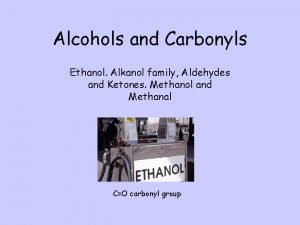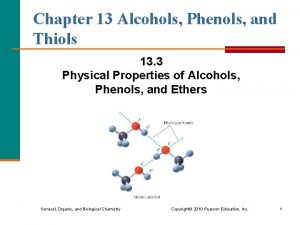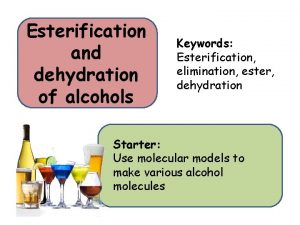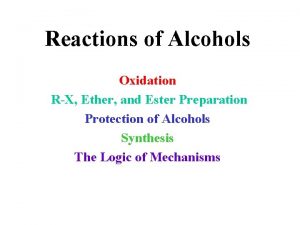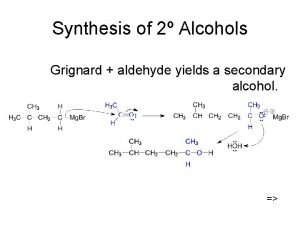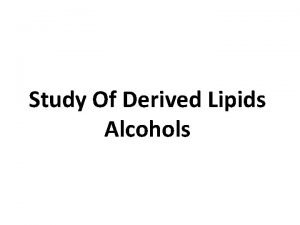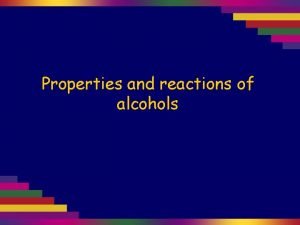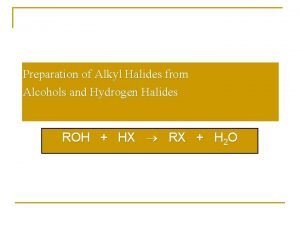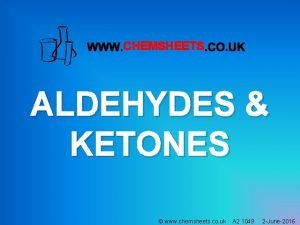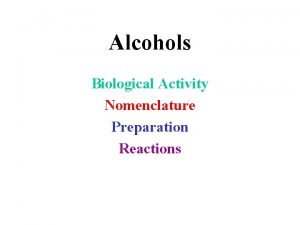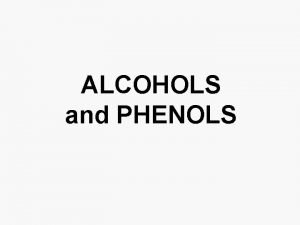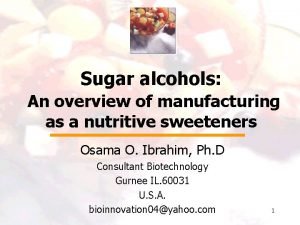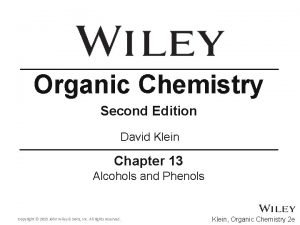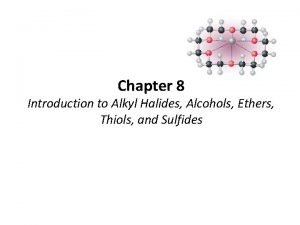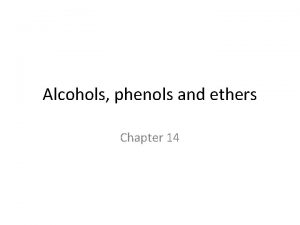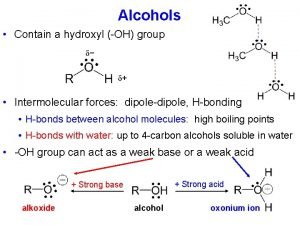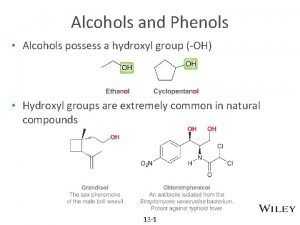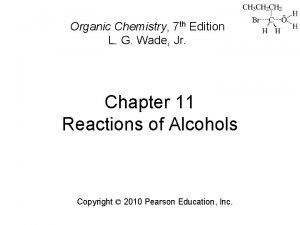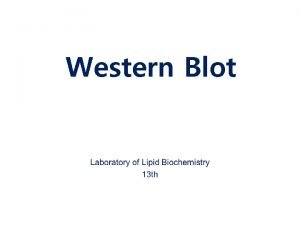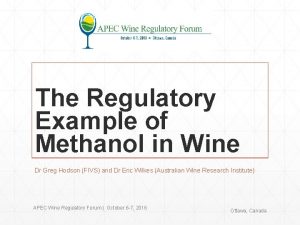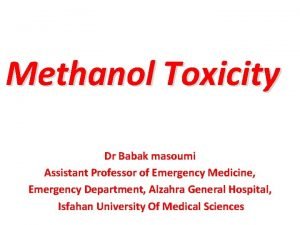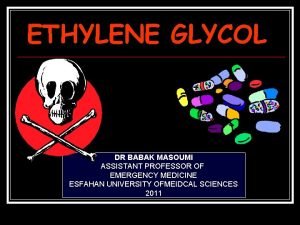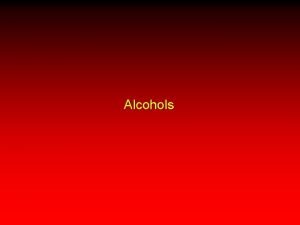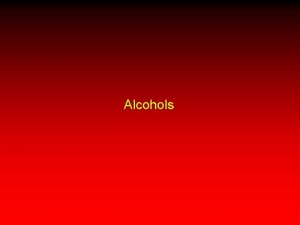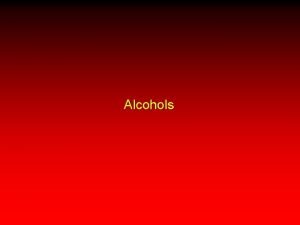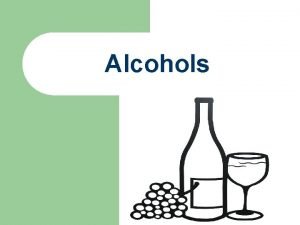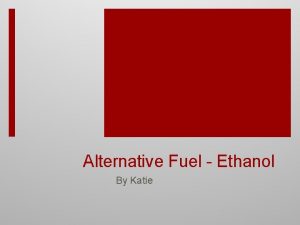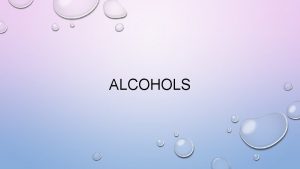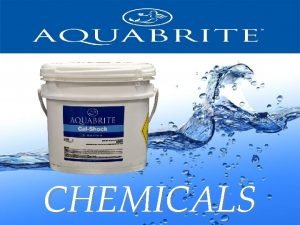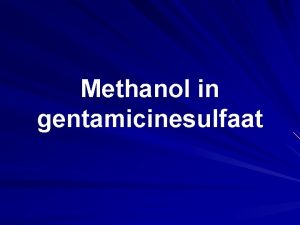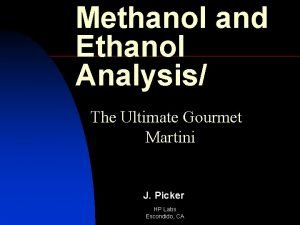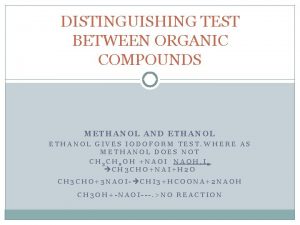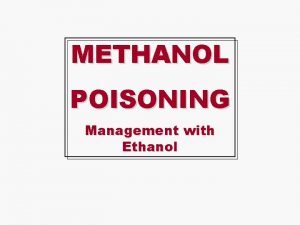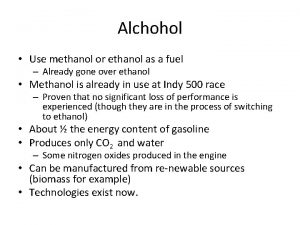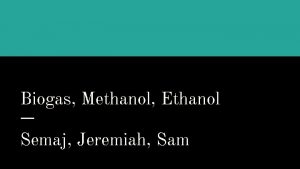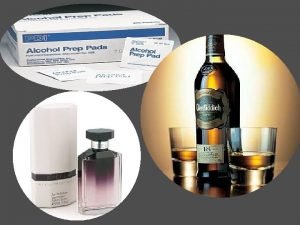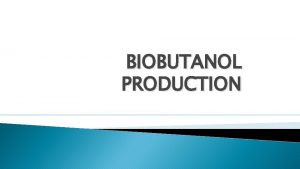Alcohols Alcohols Methanol and ethanol are industrial chemicals































- Slides: 31

Alcohols










Alcohols Methanol and ethanol are industrial chemicals: solvents, antifreeze, fuel, antiseptic, social / recreational Isopropyl alcohol is prepared by hydration of propene. All alcohols with four carbons or fewer are readily available. Most alcohols with five or six carbons are readily available.



Sources of alcohols Reactions discussed in earlier chapters Hydration of alkenes Hydroboration-oxidation of alkenes Hydrolysis of alkyl halides Diols by hydroxylation of alkenes

Sources of alcohols New methods: Reduction of aldehydes and ketones Reduction of carboxylic acids Reduction of esters Reaction of Grignard reagents

Preparation of Alcohols by Reduction of Aldehydes and Ketones

Reduction of Aldehydes Gives Primary Alcohols R R C H O H C H OH

Example: Catalytic Hydrogenation O CH 3 O CH + H 2 Pt, ethanol CH 3 O CH 2 OH (92%)

Reduction of Ketones Gives Secondary Alcohols R R C R' O H C R' OH

Example: Catalytic Hydrogenation H O + H 2 OH Pt ethanol (93 -95%)

Retrosynthetic Analysis R H C R OH H: – R C R' O C O H H H C R OH H: – R'

Metal Hydride Reducing Agents H H + Na H – B H Li + Al H H H Sodium borohydride H – Lithium aluminum hydride act as hydride donors

Examples: Sodium Borohydride Aldehyde O 2 N O O 2 N Na. BH 4 CH 2 OH CH methanol (82%) Ketone O Na. BH 4 ethanol H OH (84%)

Lithium aluminum hydride more reactive than sodium borohydride cannot use water, ethanol, methanol etc. as solvents diethyl ether is most commonly used solvent

Examples: Lithium Aluminum Hydride Aldehyde O CH 3(CH 2)5 CH 1. Li. Al. H 4 diethyl ether 2. H 2 O CH 3(CH 2)5 CH 2 OH (86%) Ketone O (C 6 H 5)2 CHCCH 3 1. Li. Al. H 4 diethyl ether 2. H 2 O OH (C 6 H 5)2 CHCHCH 3 (84%)

Selectivity neither Na. BH 4 or Li. Al. H 4 reduces isolated double bonds O 1. Li. Al. H 4 diethyl ether 2. H 2 O (90%) H OH

Preparation of Alcohols By Reduction of Carboxylic Acids and Esters

Reduction of Carboxylic Acids Gives Primary Alcohols R R C HO O H C H lithium aluminum hydride is only effective reducing agent OH

Example: Reduction of a Carboxylic Acid O 1. Li. Al. H 4 diethyl ether COH 2. H 2 O CH 2 OH (78%)

Reduction of Esters Gives Primary Alcohols Lithium aluminum hydride preferred for laboratory reductions Sodium borohydride reduction is too slow to be useful Catalytic hydrogenolysis used in industry but conditions difficult or dangerous to duplicate in the laboratory (special catalyst, high temperature, high pressure

Example: Reduction of a Carboxylic Acid O COCH 2 CH 3 1. Li. Al. H 4 diethyl ether 2. H 2 O CH 2 OH + (90%) CH 3 CH 2 OH
 Methanol versus ethanol
Methanol versus ethanol Insidan region jh
Insidan region jh Commodity chemicals vs specialty chemicals
Commodity chemicals vs specialty chemicals Carboxylic acid to tertiary alcohol
Carboxylic acid to tertiary alcohol Alcohols phenols thiols and ethers
Alcohols phenols thiols and ethers Methanol to propanoic acid
Methanol to propanoic acid Physical property of ammonia
Physical property of ammonia Why must we put all chemicals and drugs in locked cupboards
Why must we put all chemicals and drugs in locked cupboards You must put all chemicals and drugs in locked cupboards
You must put all chemicals and drugs in locked cupboards Lucas test
Lucas test Secondary alcohol to aldehyde
Secondary alcohol to aldehyde These are alcohols containing cppp nucleus?
These are alcohols containing cppp nucleus? High boiling point alcohols
High boiling point alcohols Chlorination
Chlorination Preparation of alkyl halides from alcohols
Preparation of alkyl halides from alcohols Chemsheets a2 1025 answers
Chemsheets a2 1025 answers Na2cr2o7 mechanism
Na2cr2o7 mechanism Acidity of alcohols
Acidity of alcohols Sugar alcohol names
Sugar alcohol names Alcohols nomenclature
Alcohols nomenclature Naming alkyl halides
Naming alkyl halides Ethers naming
Ethers naming Butanone isomers
Butanone isomers What does pcc ch2cl2 do
What does pcc ch2cl2 do Lucas reagent test
Lucas reagent test Tbst buffer 역할
Tbst buffer 역할 Examples of methanol
Examples of methanol Lewisstructuur methanol
Lewisstructuur methanol Methanol poisoning
Methanol poisoning Methanol vs ethylene glycol
Methanol vs ethylene glycol Npcrt
Npcrt Methanol combustion equation
Methanol combustion equation
